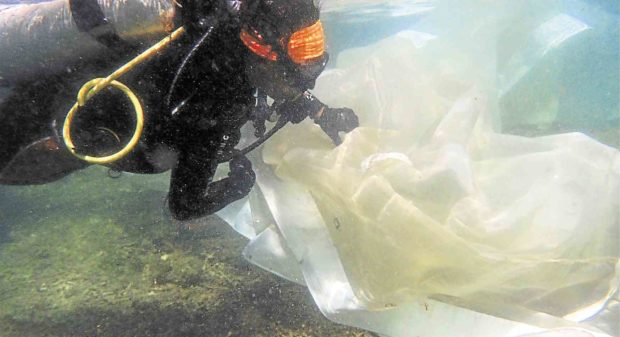On Pangasinan reef, scientists play wet nurse to new corals

‘SEA RESCUE’ The coral restoration project of the University of the Philippines Marine Science Institute hopes to repair the damage wrought by irresponsible tourism and other man-made disturbances on reefs. —CONTRIBUTED PHOTO
ALAMINOS CITY—With bated breath, researchers from the University of the Philippines Marine Science Institute (UPMSI) in Bolinao town waited for the birth of unusual “babies” in the dark and watery delivery room.
Hours later, a beautiful hue of orange filled Magsaysay reef as pregnant corals expelled millions of gametes (sperm and eggs cells) into the ocean, which divers caught and sealed inside canisters before transferring them to a “nursery.”
Since early May, researchers have been collecting gametes that would develop into larvae, or fertilized coral eggs, to replenish the coral reefs of the Hundred Islands National Park (HINP) and other systems in western Pangasinan, said Elizabeth Gomez, a UPMSI researcher.
Coral populations tend to decline due to natural and man-made disturbances in the waters, Gomez said, adding that 94 percent of the country’s reef systems have been classified as being in “poor to fair condition.”
Irresponsible tourism, for one, has degraded the coral gardens of Macapagal Island and those behind Quezon Island at the HINP, she said.
30 coral colonies
A preliminary study conducted in 2013 sought to determine whether the UPMSI’s coral restoration approach could reseed the Magsaysay reef, which is part of the Bolinao-Anda reef complex. The venture resulted in 30 coral colonies, with corals growing half a meter in diameter.
Corals spawn only once a year, often five days before and after a full moon. They are also hermaphrodites, which means they release both sperms and eggs.
Based on cues from the lunar cycle and the water temperature, entire colonies of coral reefs simultaneously release gametes into the ocean. The synchronicity is crucial because the gametes of most coral species are viable for only a few hours. The virtual blizzard of gametes make it more likely that fertilization would occur.
The pregnant corals are then collected and placed in tanks with no aeration or flow-through to keep the water calm, Gomez said.
“Like in the wild or their natural setting, the corals spawn when the water is calm, a condition that we try to replicate in the tanks,” she added.
The researchers keep watch from 5 p.m. as corals usually spawn after sunset. “We wait until 7:30 p.m. for the corals to spawn. When they don’t, we leave, and then prepare to return the following day,” Gomez said.
Larger scale
UPMSI decided to try the same process on a larger scale at the coral garden somewhere near Quezon and Macapagal islands, with 15 coral plots established on Macapagal Island which was seeded in April, and 12 plots on Quezon Island on May 7.
Each plot has 100,000 coral larvae of Acropora tenuis (branching coral) and Favites colemani (massive coral), Gomez said.
Tests showed that most of the larvae had settled in the tiles carved from dead corals and other underlying layers (substrates) in the area.
According to the US National Oceanic and Atmospheric Administration, coral larvae, also called planula, often float in the ocean for days or weeks before dropping to the ocean floor. Then, depending on seafloor conditions, the larva may attach to substrates and grow into a new coral colony at the slow rate of about 0.4 inches a year.














